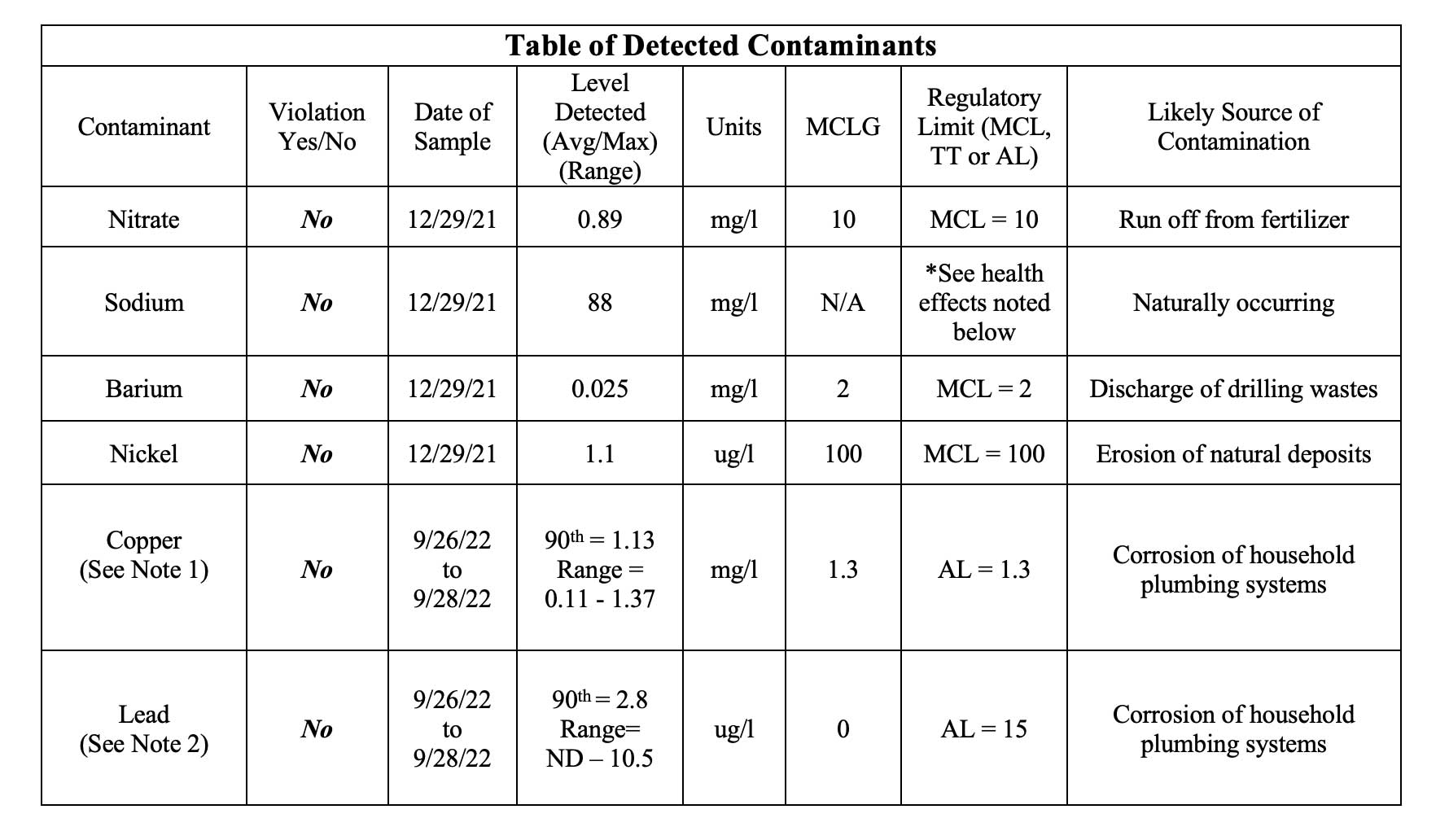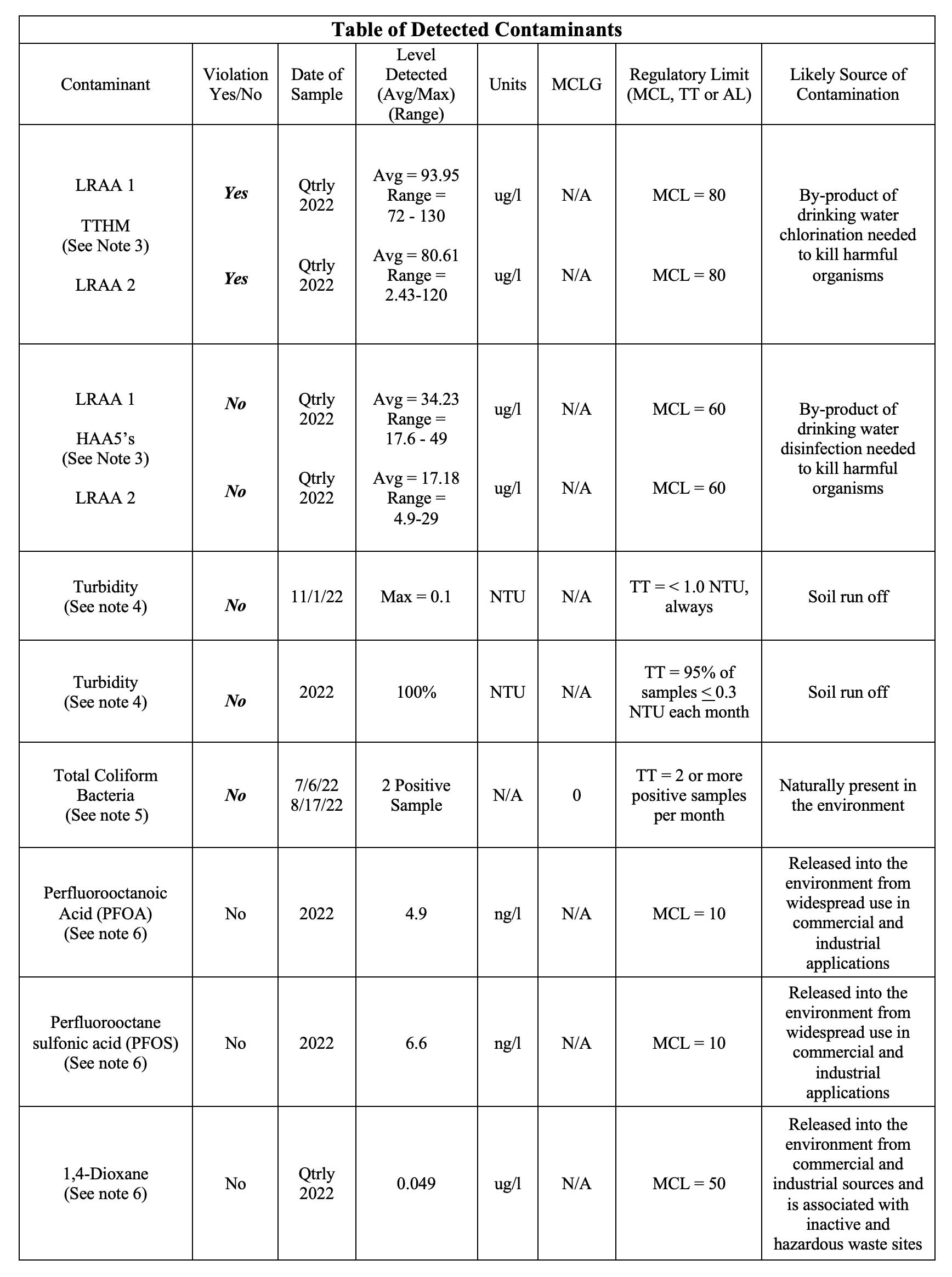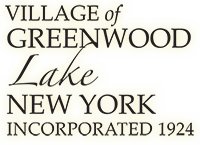Annual Drinking Water Quality Report for 2022
Village of Greenwood Lake
P.O. Box 7, Greenwood Lake, NY 10925
Public Water Supply ID# 3503530
INTRODUCTION
To comply with State regulations, the Village of Greenwood Lake Water District will be annually issuing a report describing the quality of your drinking water. The purpose of this report is to raise your understanding of drinking water and awareness of the need to protect our drinking water sources. This report provides an overview of last year’s water quality. Included are details about where your water comes from, what it contains, and how it compares to State standards.
If you have any questions about this report or concerning your drinking water, please contact Philipe Landru of Long Pond Waterworks at (845) 477-9215. We want you to be informed about your drinking water. If you want to learn more, please attend any of our regularly scheduled Village board meetings. The meetings are held every third Monday of each month at the court building at 7:30 PM.
WHERE DOES OUR WATER COME FROM?
In general, the sources of drinking water (both tap water and bottled water) include rivers, lakes, streams, ponds, reservoirs, springs, and wells. As water travels over the surface of the land or through the ground, it dissolves naturally occurring minerals and, in some cases, radioactive material, and can pick up substances resulting from the presence of animals or from human activities. Contaminants that may be present in source water include: microbial contaminants; inorganic contaminants; pesticides and herbicides; organic chemical contaminants; and radioactive contaminants. In order to ensure that tap water is safe to drink, the State and the EPA prescribe regulations which limit the amount of certain contaminants in water provided by public water systems. The State Health Department’s and the FDA’s regulations establish limits for contaminants in bottled water which must provide the same protection for public health.
Our water system serves 3,000 people through 1,200 service connections. Our water source is The Village of Greenwood Lake is supplied by 2 wells labeled E and G. Both wells are sand and gravel types. Well E is 90 feet deep and Well G is 125 feet deep. Combined Well E and Well G produce 400 gpm. Sodium permanganate is used to treat 500,000 gallons of water. Poly-aluminum chloride is used as a coagulant to help with the filtration process. The filtration is provided by two Robert’s type rapid sand filters. Also, Sodium Hypochlorite is used for disinfection and Ortho-Poly Phosphate is used for corrosion control. The filtration plant is fully automated and has 24-hour monitoring.
The NYS DOH has completed a source water assessment for this system, based on available information. Possible and actual threats to this drinking water source were evaluated. The state source water assessment includes a susceptibility rating based on the risk posed by each potential source of contamination and how easily contaminants can move through the subsurface to the wells. The susceptibility rating is an estimate of the potential for contamination of the source, it does not mean that the water delivered to the consumers is or will be contaminated. See “Table of Detected Contaminants” for a list of contaminants that have been detected. The source water assessments provide resource managers with additional information for protecting source waters into the future.
As mentioned before, our water is derived from two drilled wells. The source water assessment has rated these wells as having a high to very high susceptibility to microbials, nitrates, industrial solvents, and other industrial contaminants. These ratings are due primarily to the proximity of SPDES permitted discharge facilities (industrial/commercial facilities that discharge wastewater into the environment and are regulated by the state and/or federal government) and the low-level residential activity that are located in the assessment area. In addition, the wells draw from a confined aquifer and the overlying soils may not provide adequate protection from potential contamination. While the source water assessment rates our wells as being susceptible to microbials, please note that our water is disinfected to ensure that the finished water delivered into your home meets New York State’s drinking water standards for microbial contamination. A copy of the assessment, including a map of the assessment area, can be obtained by contacting us, as noted in this report.
ARE THERE CONTAMINANTS IN OUR DRINKING WATER?
As the State regulations require, we routinely test your drinking water for numerous contaminants. These contaminants include: total coliform, turbidity, inorganic compounds, nitrate, nitrite, lead and copper, volatile organic compounds, total trihalomethanes, haloacetic acids, radiological and synthetic organic compounds. The table presented below depicts which compounds were detected in your drinking water. The State allows us to test for some contaminants less than once per year because the concentrations of these contaminants do not change frequently. Some of our data, though representative, is more than one year old.
It should be noted that all drinking water, including bottled drinking water, may be reasonably expected to contain at least small amounts of some contaminants. The presence of contaminants does not necessarily indicate that water poses a health risk. More information about contaminants and potential health effects can be obtained by calling the EPA’s Safe Drinking Water Hotline (800-426-4791) or the orange County Health Department at 9845) 291-2331. analyzed for were detected in your drinking water.


Notes:
* Water containing more than 20 mg/l of sodium should not be used for drinking water by people on severely restricted sodium diets. Water containing more than 270 mg/l should not be used for drinking water by people on moderately restricted sodium diets.
1 – The level presented represents the 90th percentile of the 10 sites tested. A percentile is a value on a scale of 100 that indicates the percent of a distribution that is equal to or below it. The 90th percentile is equal to or greater than 90% of the values detected at your water system. In this case the 90th percentile value for copper was 1.13 mg/l. The action level for copper was exceeded at 1 of the 10 sites tested.
2 – The level presented represents the 90th percentile of the 10 sites tested. In this case the 90th percentile value for lead was 2.8 ug/l. No action levels were exceeded at any of the sites tested.
Lead info: Infants and children who drink water containing lead in excess of the action level could experience delays in their physical or mental development. Children could show slight deficits in attention span and learning abilities. Adults who drink this water over many years could develop kidney problems or high blood pressure.
3 – Total Trihalomethanes (TTHMs) and Haloacetic Acids (HAA5s) are two Disinfection Byproducts (DBPs) which have been detected in our system’s drinking water. LLRA 1 and LLRA 2 represent the sampling points in which our system is required to test for DBPs as per our sample schedule.
4 – Turbidity is a measure of the cloudiness of the water. We test it because it is a good indicator of the effectiveness of our filtration system. State regulations require that turbidity must always be <1 NTU. The regulations require that 95% of the turbidity samples collected have measurements < 0.3 NTU. Turbidity Plant is programmed to shut off if NTU exceeds 0.10 NTU.
5 – All required repeats samples were collected for coliform due to the positive test; all samples were negative; this positive sample was never confirmed.
6 – Please note that in addition to PFOS and PFOA, the lab ran the analysis for the entire EPA method 537.1, which includes 16 additional perfluorinated chemicals, 4 of these additional chemicals were detected, the highest of which was 4.5 ng/l. These additional analytes are not currently regulated and do not have an MCL.
Definitions:
Maximum Contaminant Level (MCL): The highest level of a contaminant that is allowed in drinking water. MCLs are set as close to the MCLGs as feasible.
Maximum Contaminant Level Goal (MCLG): The level of a contaminant in drinking water below which there is no known or expected risk to health. MCLGs allow for a margin of safety.
Maximum Residual Disinfectant Level (MRDL): The highest level of a disinfectant allowed in drinking water. There is convincing evidence that addition of a disinfectant is necessary for control of microbial contaminants.
Maximum Residual Disinfectant Level Goal (MRDLG): The level of a drinking water disinfectant below which there is no known or expected risk to health. MRDLGs do not reflect the benefits of the use of disinfectants to control microbial contamination.
Action Level (AL): The concentration of a contaminant which, if exceeded, triggers treatment or other requirements which a water system must follow.
Treatment Technique (TT): A required process intended to reduce the level of a contaminant in drinking water.
Nephelometric Turbidity Unit (NTU): A measure of the clarity of water. Turbidity in excess of 5 NTU is just noticeable to the average person.
Milligrams per liter (mg/l): Corresponds to one part of liquid in one million parts of liquid (parts per million – ppm).
Micrograms per liter (ug/l): Corresponds to one part of liquid in one billion parts of liquid (parts per billion – ppb).
Nanograms per liter (ng/l): Corresponds to one part of liquid to one trillion parts of liquid (parts per trillion – ppt).
Non-Detects (ND): Laboratory analysis indicates that the constituent is not present.
WHAT DOES THIS INFORMATION MEAN?
The table shows that our system uncovered some problems this year. On 9/13/22 and 11/28/22, our system received violations for MCL exceedance of Total Trihalomethanes. However, we have since come back into compliance as of 1/5/23 and are currently no longer exceeding the MCL. These violations have been closed.
We have also learned through our testing that some contaminants have been detected; however, most of these contaminants were detected below the level allowed by the State. Due to our lead & copper results we must supply the following:
If present, elevated levels of lead can cause serious health problems, especially for pregnant women, infants, and young children. It is possible that lead levels at your home may be higher than at other homes in the community as a result of materials used in your home’s plumbing. The V/O Greenwood Lake Water is responsible for providing high quality drinking water but cannot control the variety of materials used in plumbing components. When your water has been sitting for several hours, you can minimize the potential for lead exposure by flushing your tap for 30 seconds to 2 minutes before using water for drinking or cooking. If you are concerned about lead in your water, you may wish to have your water tested. Information on lead in drinking water, testing methods, and steps you can take to minimize exposure is available from the Safe Drinking Water Hotline (1-800-426-4791) or at http://www.epa.gov/safewater/lead.
Copper is an essential nutrient, but some people who drink water containing copper in excess of the action level over a relatively short amount of time could experience gastrointestinal distress. Some people who drink water containing copper in excess of the action level over many years could suffer liver or kidney damage. People with Wilson’s Disease should consult their personal doctor.
IS OUR WATER SYSTEM MEETING OTHER RULES THAT GOVERN OPERATIONS?
On 12/27/22, we had a water main break which we did not report to the Orange County Department of Health (OCDH) in a timely manner. As a result, we received a violation for not doing so on 12/30/23. We later spoke to the OCDH and brought them up to speed. This violation has been closed.
During 2022, we also received a couple violations concerning problems corresponding to 2021. However, given we received the violations during 2022, we are required to address them in this year’s report. On 1/28/22, we received a violation for failure to send in the required monthly operation report for December of 2021. We have since sent in our monthly reports and come back into compliance. We also received a violation on 3/25/23 for failure to collect 3rd and 4th quarter distribution and July biweekly entry point Lead and Copper Water Quality Parameters. We are also now back into compliance with this requirement.
DO I NEED TO TAKE SPECIAL PRECAUTIONS?
Although our drinking water met or exceeded state and federal regulations, some people may be more vulnerable to disease causing microorganisms or pathogens in drinking water than the general population. Immuno-compromised persons such as persons with cancer undergoing chemotherapy, persons who have undergone organ transplants, people with HIV/AIDS or other immune system disorders, some elderly, and infants can be particularly at risk from infections. These people should seek advice from their health care provider about their drinking water. EPA/CDC guidelines on appropriate means to lessen the risk of infection by Cryptosporidium, Giardia and other microbial pathogens are available from the Safe Drinking Water Hotline (800-426-4791).
WHY SAVE WATER AND HOW TO AVOID WASTING IT?
Although our system has an adequate amount of water to meet present and future demands, there are a number of reasons why it is important to conserve water:
- Saving water saves energy and some of the costs associated with both of these necessities of life.
- Saving water reduces the cost of energy required to pump water and the need to construct costly new wells, pumping systems and water towers; and
- Saving water lessens the strain on the water system during a dry spell or drought, helping to avoid severe water use restrictions so that essential fire fighting needs are met.
You can play a role in conserving water by becoming conscious of the amount of water your household is using, and by looking for ways to use less whenever you can. It is not hard to conserve water. Conservation tips include:
- Automatic dishwashers use 15 gallons for every cycle, regardless of how many dishes are loaded. So, get a run for your money and load it to capacity.
- Turn off the tap when brushing your teeth.
- Check every faucet in your home for leaks. Just a slow drip can waste 15 to 20 gallons a day. Fix it and you can save almost 6,000 gallons per year.
- Check your toilets for leaks by putting a few drops of food coloring in the tank, watch for a few minutes to see if the color shows up in the bowl. It is not uncommon to lose up to 100 gallons a day from one of these otherwise invisible toilet leaks. Fix it and you save more than 30,000 gallons a year.
CLOSING
Thank you for allowing us to continue to provide your family with quality drinking water this year. In order to maintain a safe and dependable water supply we sometimes need to make improvements that will benefit all of our customers. The costs of these improvements may be reflected in the rate structure. Rate adjustments may be necessary in order to address these improvements. We ask that all our customers help us protect our water sources, which are the heart of our community. Please call our office if you have questions.
